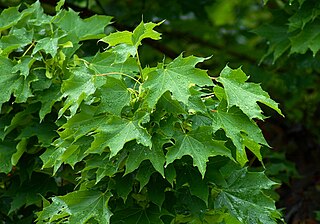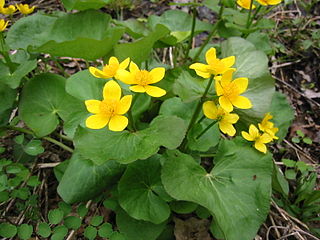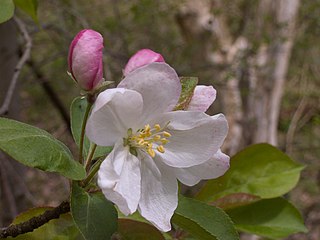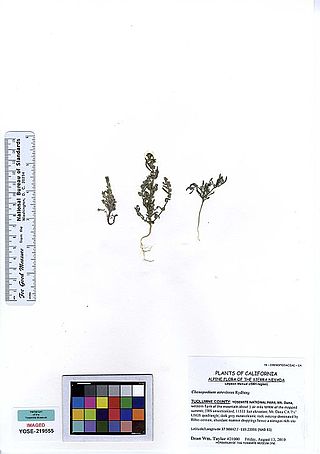
Acer platanoides, commonly known as the Norway maple, is a species of maple native to eastern and central Europe and western Asia, from Spain east to Russia, north to southern Scandinavia and southeast to northern Iran. It was introduced to North America in the mid-1700s as a shade tree. It is a member of the family Sapindaceae.

Viburnum lentago, the nannyberry, sheepberry, or sweet viburnum, is a species of Viburnum native to North America.

Leucospermum is a genus of evergreen upright, sometimes creeping shrubs that is assigned to the Proteaceae, with currently forty-eight known species.

Acer grandidentatum, commonly called bigtooth maple or western sugar maple, is a species of maple native to interior western North America. It occurs in scattered populations from western Montana to central Texas in the United States and south to Coahuila in northern Mexico.

Caltha is a genus of rhizomatous perennial flowering plants in the family Ranunculaceae, to which ten species have been assigned. They occur in moist environments in temperate and cold regions of both the Northern and Southern Hemispheres. Their leaves are generally heart-shaped or kidney-shaped, or are characteristically diplophyllous. Flowers are star shaped and mostly yellow to white. True petals and nectaries are missing but the five or more sepals are distinctly colored. As usual in the buttercup family there is a circle of stamens around free carpels.

Hibiscus laevis, the halberd-leaf rosemallow, is a herbaceous perennial flower native to central and eastern North America. Their showy, creamy-white or pink flowers are large, up to 15 centimetres (6 in) across, and are hard to miss. These flowers require exposure to sunlight to open up properly, and then last only a single day.

Brachychiton is a genus of 31 species of trees and large shrubs, native to Australia and New Guinea. Fossils from New South Wales and New Zealand are estimated to be 50 million years old, corresponding to the Paleogene.

Paeonia brownii is a low to medium height, herbaceous perennial flowering plant in the family Paeoniaceae. It has compound, steely-gray, somewhat fleshy leaves and small drooping maroon flowers. Its vernacular name is Brown's peony, native peony or western peony. It is native to the western United States and usually grows at altitude, often as undergrowth in part-shade. The fleshy roots store food to carry the plant through the dry summers and produce new leaves and flowers the following spring.

Crataegus laevigata, known as the Midland hawthorn, English hawthorn, woodland hawthorn, or mayflower, is a species of hawthorn native to western and central Europe, from Great Britain and Spain east to the Czech Republic and Hungary. It is also present in North Africa. The species name is sometimes spelt C. levigata, but the original orthography is C. lævigata.

Catalpa bignonioides is a short-lived species of Catalpa that is native to the southeastern United States in Alabama, Florida, Georgia, Louisiana, and Mississippi. Common names include southern catalpa, cigartree, and Indian bean tree It is commonly used as a garden and street tree.

Momordica balsamina is a tendril-bearing annual vine native to the tropical regions of Africa, introduced and invasive in Asia, Australia, Central America, and North America, where they have been found in some parts of Florida. In 1810, Thomas Jefferson planted this vine in his flower borders at Monticello along with larkspur, poppies, and nutmeg.

Aphloia is a genus of flowering plants that contains a single species, Aphloia theiformis, the sole species of the monogeneric family Aphloiaceae. It is a species of evergreen shrubs or small trees occurring in East Africa, Madagascar, the Mascarene Islands and the Seychelles.

Malus coronaria, also known by the names sweet crabapple or garland crab, is a North American species of Malus (crabapple).

Palaquium ravii is a species of tree in the family Sapotaceae. It is endemic to the Western Ghats mountains and native to Kerala and Tamil Nadu in India.

Gentiana newberryi is a species of gentian known by the common names alpine gentian and Newberry's gentian. It is a perennial herb found in western North America.

Cuttsia viburnea is a shrub or bushy tree which has toothed leaves and panicles of white flowers, and that is endemic to eastern Australia. It is sometimes called silver-leaved cuttsia, and confusingly also native elderberry, honey bush or native hydrangea. C. viburnea is the only species assigned to the genus Cuttsia.

Chenopodium atrovirens is a species of flowering plant in the amaranth family known by the common names pinyon goosefoot and dark goosefoot.

Croton verreauxii, known as the green native cascarilla, is a small tree or shrub growing in dry rainforest and rainforest margins in eastern Australia.

Paeonia ludlowii, is a deciduous shrub of medium height, belonging to the tree peony section Moutan of the genus Paeonia, and endemic to southeast Tibet. In Tibet it is known as ≠'lumaidao' meaning "God's flower". The vernacular name in Chinese is 大花黄牡丹 meaning "big yellow-flowered peony". In English it is sometimes called Tibetan tree peony or Ludlow's tree peony. It has pure yellow, slightly nodding, bowl-shaped flowers, and large, twice compounded, light green leaves.

Bossiaea aquifolium, commonly known as water bush, nedik or netic, is a species of flowering plant in the pea family Fabaceae and is endemic to Southwest Australia. It is a slender shrub or small tree with egg-shaped leaves arranged in opposite pairs and yellowish flowers arranged singly or in pairs on the ends of branchlets.




















